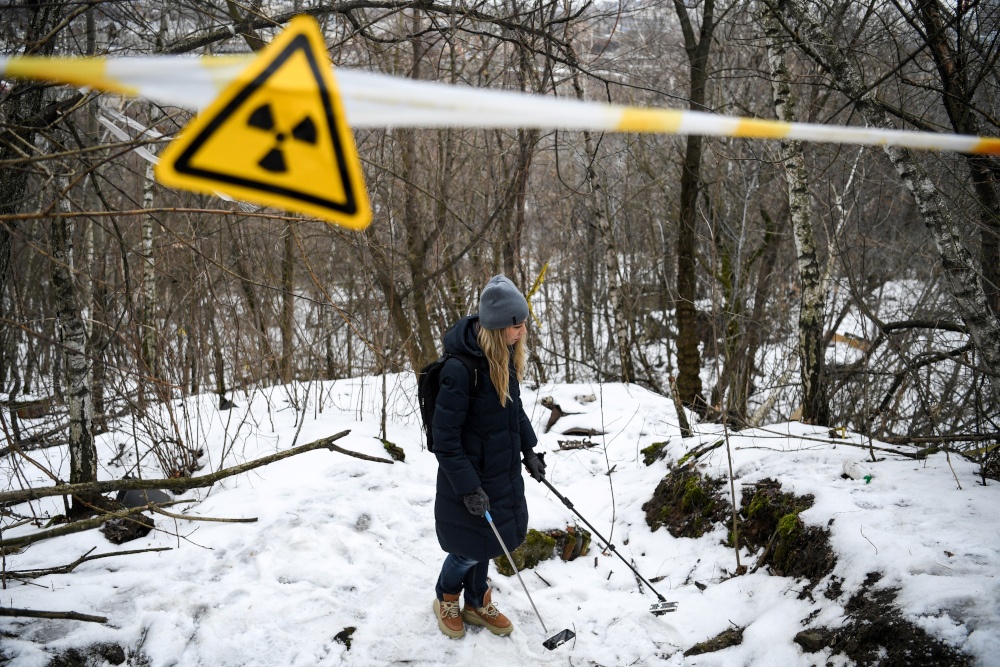MOSCOW, March 13 — Armed with a selfie stick holding a dosimeter-equipped smartphone, nuclear physicist Andrei Ozharovsky is on the hunt for gamma radiation.
Waving the device over a shallow dip in the thawing ground, the contraption crackles as the reading climbs, turning first yellow then red.
The dosimeter is picking up spots of elevated gamma radiation on the tree-lined hill close to a busy commuter train station and blocks of flats.
But what concerns Ozharovsky and local residents most is the plan to build an eight-lane motorway over the slope, which contains radioactive waste buried in the pre-Chernobyl Soviet era.
Nearby, work is already in full swing for the new road.
“The real horror is that we are standing on the exact spot where the highway is planned,” says Ozharovsky, who has examined the site over the past year.
“As soon as you remove the surface layer, it registers elevated levels. That means we are standing on top of radioactive waste,” he says, as the figure on the dosimeter increases to over one microsieverts per hour, meaning that if you stood there for an hour you would be exposed to one microsieverts of radiation.
That is more than three times higher than background radiation, and, while still not dangerous to be around, indicates higher levels underground that would be spread as dust and end up in people’s lungs, Ozharovsky says.
Russian building regulations require additional inspections of sites with radiation of over 0.6 microsieverts per hour to determine if a cleanup is possible before a decision on construction can be taken.
But documentation for the highway project — part of a plan by powerful mayor Sergei Sobyanin for four such roads — says that “no radioactive contamination has been found at the site.”
Moscow ‘is not Pripyat’
The new road, named the South-East Expressway, will connect ten outlying neighbourhoods bypassing the congested city centre.
It will skirt the radioactive site next to the Moscow Polymetals Plant, formerly a top-secret facility that produced the radioactive element thorium for nuclear reactors until the 1970s.
Working in the era before the 1986 Chernobyl nuclear disaster when radiation risks were underestimated, the plant simply dumped waste in its backyard, on the slope descending to the Moskva River.
Its land with unmarked radioactive spots was eventually transferred to the city of 12 million, whose mayor is keen to redevelop post-industrial wasteland.
“We are extremely concerned that construction workers will disturb this radioactive burial site,” says activist Ivan Kondratyev whose father lives nearby.
Shifting the soil “will spread (radioactive waste) in the form of particles and droplets and harm people’s health,” Kondratyev says.
“This is not Pripyat,” a protest sign nearby declares, referring to the town built for workers at Chernobyl nuclear power station that had to be evacuated following the disaster and is still uninhabitable.
After blocking construction equipment from entering the area in January, activists pitched in to buy a used mini-van that now serves as a base for round-the-clock monitoring.
Activists shelter from the cold inside, fuelled by hot tea and biscuits provided by neighbours.
Hundreds more follow a dedicated channel on Telegram messenger service, ready to show up in larger numbers to stop works.
Mayor Sobyanin in late January admitted for the first time that the slope contains “radioactive waste”, but insisted there were only “insignificant traces of contamination” on the road’s route.
“According to experts, they don’t interfere with construction,” he said, promising to “ship dirty soil out of Moscow” if workers find more in the process.
Activist Kondratyev questions why the mayor did not provide figures and why the city spent months denying there was a problem.
“This is some sort of cat-and-mouse game, a totally immature approach,” he says.
Moscow’s leadership “doesn’t understand what they physically have in their city.”
The city hall’s construction department that oversees the highway project refused an interview request from AFP.
‘Crazy project’
Activists are calling for road construction to be put on hold until a fresh assessment of the site, along with public hearings.
Building would disturb soil with “unpredictable” radiation levels, and radioactive dust would “spread along considerable distances,” says Greenpeace Russia.
It has launched legal action against the project, with hearings scheduled for April.
It wants the initial environmental impact study that found no traces of radiation to be ruled legally invalid.
But the city is unlikely to stall the showpiece 28-kilometre road project for long.
In the activists’ van, local resident Yelena Ageyeva says she will hold out “till the end” to prevent construction work she believes will be dangerous for her children and grandchildren.
“We’ll be the first people to be hit with whatever it is they dig up when they put in the highway supports,” she says, calling it a “crazy project”.
“We cannot allow an environmental catastrophe in the city.” — AFP






















